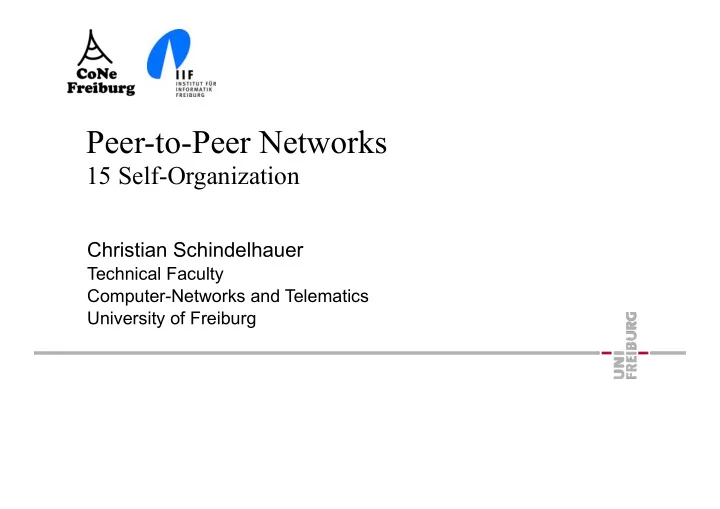

Peer-to-Peer Networks 15 Self-Organization Christian Schindelhauer Technical Faculty Computer-Networks and Telematics University of Freiburg
Gnutella — Connecting Protokoll - Ping Ping • participants query for Ping neighbors Ping Ping Pong • are forwarded according for TTL steps (time to live) Ping Pong - Pong Ping Pong Pong Ping • answers Ping Pong • is forwarded backward on Pong the query path Pong • reports IP and port adress (socket pair) • number and size of available files 2
Degree Distribution in Gnutella Modeling Large-scale Peer-to-Peer Networks and a Case Study of Gnutella - Mihajlo A. Jovanovic, Master Thesis, 2001 The number of neighbors is distributed according a power law (Pareto) distribution - log(#peers with degree d) = c - k log d - #peers with degree d = C/d k 3
Pareto-Distribution Examples Pareto 1897: Distribution of wealth in the population Yule 1944: frequency of words in texts Zipf 1949: size of towns length of molecule chains file length of Unix-system files …. 4
Pareto Verteilung Discreet Pareto-Distribution for x ∈ {1,2,3,…} - with constant factor - (also known as Riemann´s Zeta-function) Heavy tail property - not all moments E[X k ] exist - the expectation exists if and only if (iff) α >2 - variance and E[X 2 ] exist iff α >3 - E[X k ] exists iff α >k+1 Density function of the continuous function for x>x 0 5
Indegree and Outdegree of Web-Pages are described by a power law (Pareto) distribution Experiments of - Kumar et al 97: 40 millions Webpages - Barabasi et al 99: Domain *.nd.edu + Web-pages in distance 3 - Broder et al 00: 204 millions web pages (Scan Mai und Okt. 1999) 6
Connectivity of Pareto Graphs William Aiello, Fan Chung, Linyuan Lu, A Random Graph Model for Massive Graphs, STOC 2000 Undirected graph with n nodes where - the probability of k neighbors for a node is p k - where p k = c k - τ for some normalizing factor c Theorem - For sufficient large n such Pareto-Graphs with exponent τ we observe • for τ < 1 the graph is connected with probability 1-o(1) • for τ > 1 the graph is nont connected with probability 1-o(1) • for 1< τ <2 there is a connected component of size Θ (n) • for 2< τ < 3.4785 there is only one connected component of size Θ (n) and all others have size O(log n) • for τ >3.4785: there is no large connected component of size Θ (n) with probability 1-o(1) • For τ >4: no large connected components which size can be described by a power law (Pareto) distribution 7
Zipf Distribution as a Variant of Power Laws George Kinsley Zipf claimed - that the frequency of the n most frequent word f(n) - satisfies the equation n f(n) = c. Zipf probability distribution for x ∈ {1,2,3,…} - with constant factor c only defined for connstant sized sets, since - is unbounded Zipf distribution relate to the rank - The Zipf exponent α may be larger than 1, i.e. f(n) = c/n α Pareto distribution realte the absolute size, e.g. the number of inhabitants 8
Size of towns Scaling Laws and Urban Distributions, Denise Pumain, 2003 Zipf distribution 9
Zipf’s Law and the Internet Lada A. Adamic, Bernardo A. Huberman, 2002 Pareto Distribution!! 10
Heavy-Tailed Probability Distributions in the World Wide Web Mark Crovella, Murad, Taqqu, Azer Bestavros, 1996 11
Small World Phenomenon Milgram’s experiment 1967 - 60 random chosen participants in Wichita, Kansas had to send a packet to an unknown address - They were only allowed to send the packet to friends • likewise the friends The majority of packtes arrived within six hops Small-World-Networks - are networks with Pareto distributed node degree - with small diameter (i.e. O(log c n)) - and relatively many cliques Small-World-Networks - Internet, World-Wide-Web, nervous systems, social networks 12
How do Small World Networks Come into Existence? Emergence of scaling in random networks, Albert-Laszlo Barabasi, Reka Albert, 1999 Preferential Attachment-Modell (Barabasi-Albert): - Starting from a small starting graph successively nodes are inserte with m edges each (m is a parameter) - The probability to choose an existing node as a neighbor is proportional to the current degree of a node This leads to a Pareto network with exponent 2,9 ± 0,1 - however cliques are very seldom Watts-Strogatz (1998) - Start with a ring and connections to the m nearest neighbors - With probability p every edge is replaced with a random edge - Allows continuous transition from an ordered graph to chaos Extended by Kleinberg (1999) for the theoretical verification of Milgram‘s experiment 13
Analyzing Gnutella Modeling Large-scale Peer-to-Peer Networks and a Case Study of Gnutella - Mihajlo A. Jovanovic, 2001 14
Analyzing Gnutella Modeling Large-scale Peer-to-Peer Networks and a Case Study of Gnutella - Mihajlo A. Jovanovic, 2001 Comparison of the characteristic path length - mean distance between two nodes 15
Peer-to-Peer Networks 15 Self-Organization Christian Schindelhauer Technical Faculty Computer-Networks and Telematics University of Freiburg
Recommend
More recommend